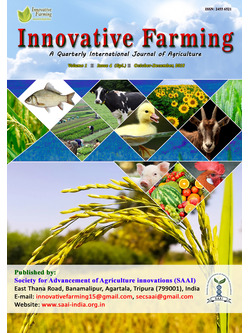
Advanced Farming Systems in Aquaculture: Strategies to Enhance the Production
Alok Kumar Jena*
Dept. of Aquaculture, College of Fisheries, Lembucherra, Tripura, INDIA
Pradyut Biswas
Dept. of Aquaculture, College of Fisheries, Lembucherra, Tripura, INDIA
Himadri Saha
Dept. of Aquatic Health and Environment, College of Fisheries, Lembucherra, Tripura, INDIA
DOI: NIL
Keywords: Fish farming, Water quality, Water recirculation, Ecological aquaculture
Abstract
Aquaculture is one of the most emerging sectors growing like industries, providing an ultimate livelihood option to a millions of peoples of India. The current aquaculture production is not able to meet the growing demand for fish due to intensification of human population. Aquaculture must have to move towards intensification to meet the rising demand, to contribute more effectively to the reduction of poverty and malnutrition, and to become ecologically more sustainable. New technologies will make it possible for sustainable aquaculture to become the new global standard. In order to improve the socio-economic condition of the farmers, this expansion of aquaculture production needs to take place in a sustainable way through the applications of new farming interventions viz. integrated farming, Aquaponics, Recirculatory aquaculture system (RAS), Neo-female Technology, Biofloc technology (BFT), Compensatory growth Technology etc.
Downloads
not found
Reference
Ali, M., Nicieza, A., and Wootton, R. J. (2003). Compensatory growth in fishes: a response to growth depression. Fish and Fisheries, 4(2), 147–190.
Amir, S. (2013). Monosex culture of prawns through androgenic gene silencing. Infofish International, 10(4), 22–24.
Avnimelech, Y. (2009). Biofloc Technology — A Practical Guide Book. World Aquaculture Society, Baton Rouge, Louisiana, United States, pp. 182.
Ayyappan, S. (2011). Handbook of Fisheries and Aquaculture. Indian Council of Agricultural Research, New Delhi, India, pp. 439–448.
Azad, K. N., and Salam, M. A. (2016). Aquaponics in Bangladesh: current status and future prospects. Journal of Bioscience and Agriculture Research, 7(2), 669–677.
Barrington, K., Chopin, T., and Robinson, S. (2009). Integrated multi-trophic aquaculture (IMTA) in marine temperate waters. In: FAO Fisheries and Aquaculture Technical Paper No. 529, FAO Press, Rome, Italy, pp. 7–46.
Biswas, P., Datta, M. K., Saha, H., and Mandal, S. C. (2016). Stunted fingerlings–replacement of conventional fish seed. In: Vocational Training Manual on Aquaculture Production and Its Management. College of Fisheries, Central Agricultural University, Imphal, pp. 59–61.
Crab, R., Defoirdt, T., Wille, M., Bossier, P., and Verstraete, W. (2012). Biofloc technology in aquaculture: Beneficial effects and future challenges. Aquaculture, 356, 351–356.
Prein, M., Bergleiter, S., Ballauf, M., Brister, D., Halwart, M., Hongrat, K., Kahle, J., Lasner, T., Lem, A., Lev, O., Morrison, C., Shehadeh, Z., Stamer, A., and Wainberg, A. A. (2010). Organic aquaculture: the future of expanding niche markets. In: Proceedings of the Global Conference on Aquaculture, Phuket, Thailand, September 22–25, pp. 549–567.
